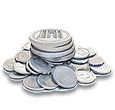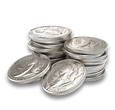What Really Drives Coin Premiums?
- GoldsilverJapan

- Sep 26
- 6 min read
Understanding Supply, Demand, and Collector Psychology
In the world of numismatics and precious metals investing, one question puzzles both beginners and seasoned collectors alike: Why do some coins trade far above their intrinsic metal value? The answer lies in a complex interplay of supply, demand, and collector psychology—all of which contribute to what is commonly known as the coin premium.
Whether you're purchasing a modern silver bullion coin like the American Silver Eagle or a centuries-old Roman denarius, premiums affect how much you'll pay—and how much you'll eventually get when you sell.
This article explores the true drivers behind coin premiums, explains why they exist, how they fluctuate, and what smart investors and collectors can do to navigate these nuanced dynamics effectively.
📌 What Is a Coin Premium?
Before diving into the causes, let's clarify the terminology:
Spot Price: The current market price for a metal (gold, silver, platinum, etc.).
Intrinsic Value (Melt Value): The amount of precious metal in a coin multiplied by the spot price.
Premium: The amount over the intrinsic value that a buyer pays. This can be a percentage or a flat amount.
For example:If silver is $50/oz and a Silver Eagle costs $70, the $20 difference is the premium, representing a 40% markup.
🧮 Key Categories of Coin Premiums
Different types of coins come with different kinds of premiums:
Coin Type | Typical Premiums | Key Factors |
Bullion Coins | 3% – 25% | Metal value, mint, demand, logistics |
Semi-Numismatic | 10% – 100% | Design, mintage, collectibility |
Numismatic Coins | 50% – 1000%+ | Historical rarity, grade, age |
Commemorative/Proof | 10% – 500% | Limited runs, condition, packaging |
Understanding where your coin fits in this spectrum is the first step in evaluating a fair price.
🏗️ Supply: The Backbone of Premiums
1. Mintage Numbers
The number of coins minted by a national mint or private producer heavily influences supply.
High mintage coins (e.g., Silver Britannia, Maple Leafs) often carry lower premiums due to wide availability.
Low mintage coins (e.g., Perth Mint's Lunar Series, Austrian Philharmonic Proofs) often attract higher premiums, especially once the run ends.
2. Surviving Population
Just because a coin was minted in large quantities doesn’t mean many survived.
Coins from ancient times or war periods may be rare today due to:
Melting for metal
Loss in circulation
Destruction during conflict
These lower actual supplies naturally increase premiums.
3. Mint Shutdowns and Disruptions
During the COVID-19 pandemic, multiple mints like the Royal Canadian Mint and the U.S. Mint experienced shutdowns, which led to sudden drops in supply and soaring premiums—especially for popular bullion products.
💹 Demand: The Market Forces You Can’t Ignore
While supply sets the stage, demand drives the action. When demand exceeds supply, premiums shoot up.
1. Investor Demand
When global uncertainty rises (e.g., inflation, wars, banking crises), precious metal demand surges. More people flock to gold and silver as "safe haven" assets, driving premiums upward.
Example:During the 2008 financial crisis and the 2020 pandemic, premiums on Silver Eagles and Gold Britannias more than doubled.
2. Collector Demand
Collectors drive demand differently. They are less concerned about metal prices and more interested in:
Aesthetics
Historical significance
Mint marks
Completeness of series (e.g., all 12 coins of the Lunar Series)
A spike in collector interest—for example, when a series ends or a monarch changes—can send premiums skyrocketing.
3. Trend-Driven Demand
Some coins become fashionable. For example:
The Australian Swan coin launched in 2017 with huge hype and was selling at a 70–100% premium.
Over time, the market treated it more like bullion as demand stabilized.
Such hype-driven demand usually leads to short-term spikes, followed by corrections.
🧠 Collector Psychology: The X-Factor in Premium Pricing
Here’s where things get truly interesting.
Coins are not like stocks or commodities. They appeal to emotions, nostalgia, and human psychology—factors that heavily influence premiums.
1. Fear and Greed
These two primal emotions dominate financial decisions.
Fear: During crises, people rush to buy gold and silver, fearing fiat currency collapse. Premiums rise.
Greed: When people believe a coin series will appreciate massively (e.g., early issues of the Queen’s Beasts), they overpay, hoping to sell later at a higher price.
2. FOMO (Fear of Missing Out)
Limited-edition releases often create urgency. Mints use phrases like:
“Only 5,000 pieces worldwide!”
“Final coin in the series!”
This taps into scarcity psychology, driving premiums beyond logical levels.
3. Herd Mentality
When forums, influencers, or media outlets start buzzing about a coin, demand rises.
Example:
A YouTube influencer highlights a rare U.S. commemorative coin.
Demand explodes, and so does the price—even if the coin’s fundamentals don’t support it.
💰 Real-World Examples: What Happened and Why?
A. 1933 Saint-Gaudens Double Eagle
Melt value: ~$2,000 (gold content)
Sold at auction: $18.9 million
Reason: Rarity + legal battle + historical significance = perfect storm of high premium.
B. Silver American Eagles (2020)
Spot: ~$25
Price: ~$40
Reason: COVID-19, mint closures, soaring demand, and collector frenzy for 2020-dated coins.
C. Japanese Commemorative Coins
Older Olympic and imperial coins were highly sought after by local collectors.
Emotional and cultural value can elevate a coin far beyond metal or mintage factors.
⚖️ Understanding Market Timing and Volatility
1. Premium Compression
When spot prices surge, premiums often compress because:
Buyers become price-sensitive.
Dealers have higher volumes and lower margins.
But when spot is stable or falling, premiums widen as dealers attempt to maintain profit.
2. Seasonal Trends
Lunar New Year → Surge in gold demand in Asia
October–December → Holiday gifting season sees spikes in demand
These predictable patterns affect premiums annually.
🔍 How to Evaluate a Coin’s Premium Wisely
Use these questions to judge if a coin’s premium is justified:
What’s the mintage and surviving population?
Is the coin graded and certified?
What’s its historical or emotional significance?
Is it part of a popular series?
What’s the current demand trend?
Are you buying at the peak of hype?
🛑 Common Mistakes When Paying Premiums
1. Ignoring Secondary Market Data
Just because a dealer lists a coin at $200 doesn’t mean it sells for that. Always check:
eBay sold listings
Auction houses
Coin forums
2. Buying for Hype, Not Value
Don’t get caught up in the buzz. Ask yourself:
“Would I still want this coin if I couldn’t sell it for 10 years?”
3. Overpaying for Condition When Supply Is Plentiful
Some modern coins in MS70 are so common that paying an extra $100 makes no financial sense.
📈 Can You Profit from High Premiums?
Yes, but only if:
You time the market correctly.
You anticipate demand (e.g., a monarch dies or a series ends).
You buy before a premium spike and sell after.
However, reselling to dealers often results in losing the premium. Private buyers or auctions yield better chances of recovering your investment.
🌎 Global Differences in Premium Culture
Region | Buyer Behavior | Premiums |
U.S. | Bullion-focused, love MS70s | Moderate |
Europe | Historical, prefer old gold | High for numismatics |
Asia | Cultural symbols, gold-focused | High for commemoratives |
Middle East | Heavy gold buying, wedding culture | High for purity |
Understanding regional tastes helps when selling internationally.
🛍️ Where to Buy Coins with Reasonable Premiums
Trusted Global Platforms
Apmex
JM Bullion
Royal Mint
Perth Mint
Tanaka Kikinzoku (Japan)
Japan-Based Trusted Dealer
GoldSilverJapan GoldSilverJapan | Buy Rare Coins, Silver & Gold Online
Offers a mix of bullion, collectible, and rare international coins.
Strong focus on educational support and honest pricing.
✅ Final Tips for Smart Coin Buyers
Track Spot Price Daily – Use it to judge the true premium.
Compare Across Sellers – Don't buy from the first website.
Avoid Emotional Buying – Collecting should be joyful, not stressful.
Look at Trends – Study historical data of coins you like.
Buy Low, Sell High – Time purchases and sales around global events.
🧭 Conclusion: Premiums Reflect More Than Metal
Coin premiums are shaped by far more than just weight or composition. They are a mirror of human psychology, a reflection of supply chains, and an indicator of collector passion. Understanding what drives these premiums—from minting numbers to emotions—empowers you to make smarter purchasing and selling decisions.
Whether you're buying a modern bullion coin or a Roman relic, keep in mind:
The premium is the price of the story, not just the metal.
And stories, as history has shown, often hold their value even when markets do not.











Comments